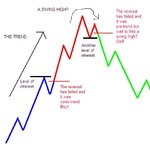Tops and Bottoms - And How to Avoid Them
The last thing you want to do is get in at the top of the move for a Short or at the bottom of the move for a Long. Right?
(OK. A joke, but you probably wouldn’t be amazed how many bods I have had dealings with that develop pretty sound trading systems which deliver a consistent profit, but then try and ‘fit’ them to capture more of a move or every move, and you can hear that poor Goose being killed a mile away. Shameful.)
But what reversals do, is provide a fairly obvious combination of factors and relationships which can often be utilised.
NB. This is for newbies only. All you pros and old hands know all this.
Forgetting the ‘getting in’ bit for the moment and concentrating on the ‘getting out’ bit, there are maybe a dozen or so methods for getting out that I discovered out of the couple of million that actually exist, all of which are far better than mine. However, one of these I have had some success with, you may care to play around with yourself.
There’s never a good time to get out of a trade unless it’s reached its maximum departure away from the entry point - in your favour. I have accidentally hit this spot a few times in my trading career. Most of the time, I’m getting out and either leaving some on the table or getting out after having given back a bit. I’m really very OK with that.
A useful exit condition to potentially incorporate with all your other good stuff on exit strategies, is to check the breach of the bar before last’s High or Low.
If you’re Short, and the current bar’s High breaches the High of the bar before last (+fuzz factor – where fuzz is suck it and see for your chosen instrument and chosen timeframe, but a couple of pips should do nicely on any of the lower TF FX plays), it’s often a pretty good time to get out. You can always get back in if it starts down again and your entry setups confirm.
And if you’re Long, and the current bar’s Low breaches the low of the low of the bar before last (-fuzz factor), ditto.
Working with the prior bar is too tight, but the bar before last, in any given timeframe, causes all the traders you are up against in that instrument and in that timeframe to have complete amnesia and forget all about it. Which is why it’s significant.
This all gets quite pointless where you have an oversize bar (your call, I take anything that’s double the range of anything over the last X bars, but it’s your method now), so don’t try and use it where there are obvious disincentives to do so. It’s just another potential tool for you to consider putting in your toolbox.

